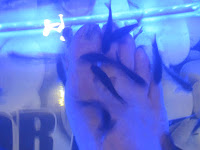It was a chilly morning with threatening clouds as Claudette and I got off the bus at Hierapolis. We moved through the gate, putting our tickets through the scanners before beginning a long road into the ruins of the city of Hierapolis. Founded in the second century B.C. it had always been a city famous for its spas. The wide street was paved with stone, and the sewer ran beside it. The water still flowed in the ancient sewers, and you could see it where there were flat stones missing. There were toppled columns on either side.
We entered the main part of the city through an arched gate of stone. The Romans were great stone cutters and engineers. Many structures have no cement between the huge stone blocks. The clouds became more ominous, and the mist thickened. To our left were the travertines, large deposits of calcium. The white deposits from the mineral water appeared as cooled lava would have appeared had it been white. The mineral water still flows, and one can walk barefoot in it as it flows over the calcium deposits. This was a city of 100,000 at its peak, and although it was not founded by the Romans it was rebuilt by them four many earthquakes.
We continued our walk by the Roman baths which are now the museum of Hierapolis. It is a vaulted structure of several buildings which also contained a gymnasium and a library. When Emperor Constantine declared Christianity the religion of the Roman Empire, the Christians closed the baths. Further along the way the street dead-ends in front of a modern structure; a place to get food and enter the hot springs. The water temperature is 98.6F to 134.6F.We do not bathe, but we watch others. It is amusing to watch the clouds of steam rising from the pools. Behind this spa is the theater, which is under restoration, and on the side of the hill is the martyrium. This is the final resting place of the apostle Phillip who was crucified upside-down here about 56 A.D.. However, there is some question about which Phillip it was. There seems to have been several "Phillip the Apostles" around.
The rain began to fall harder, and we decided it was time to return to the big Mercedes-Benz tour bus. On our left opposite the museum is the necropolis. Did I mention that Hierapolis's major attraction was the mineral baths? For that reason many migrated here to find a cure for their ills. Many died here, cured or not. Many graves are those of Christians and Jews. We found a bit of shelter under some trees as we turn the corner and watched the people barefoot in the mineral water flowing nearby. Finally, we returned to the entrance and decided on a glass of tea. There is a post office, several cafes, and souvenir shops there. I bought a postage stamp for 2 lira to paste in my sketchbook. I'm sure there was a cheaper stamp, but I could not get the clerk to understand. Sometimes the language barrier is insurmountable. We ducked into a small cafe and asked for tea. The proprietor was quick to offer cups of tea, but I said that I wanted a glass, or rather two glasses. Before he could tell me the price I put four lira on the counter. This is the normal price for a glass of tea, but some cafe operators are quick to double the price if you aren't careful. Turkish tea is strong and sweet. I love it!
We left Hierapolis with our tour guide telling us about Russian vacationers causing a problem with the Turkish workers working on the city's restoration. It seemed the Russian ladies preferred to enjoy the baths topless. Concentration on their tasks was difficult for the Turks, and some concessions in bathing attire was made by the Russians.
Little did we, Claudette and I, know that we were headed for a feeding frenzy at our hotel. Our hotel was a modern structure with many water features: swimming pool, thermal pool, and whirlpool. In this area marble abounds, on floors as well as walls. There was also another kind of pool; the kind of pool you put your feet in and allow small fish to eat the dead skin from you feet. Naturally, I could not pass up such an opportunity. This small fish, less than two inches long, gama rufa is sometimes called the "nibble" fish. Its name is well deserved, because when you put your feet in the fish tank, the size of a small aquarium, the fish immediately begin to nibble on your feet. It's quite a sensation. There are dozens of these little buggers having a feeding frenzy on your feet. They are looking for food. They don't actually eat the dead skin but pull it off searching for food.
The day began and ended with rain, but it was quite a day in Hierapolis and Pamukkale. Wi-fi wasn't working, and there was nothing in English on television, and we were ready for a good night's sleep. Besides, we needed to rest up for our next adventure.

.JPG)
.jpg)
